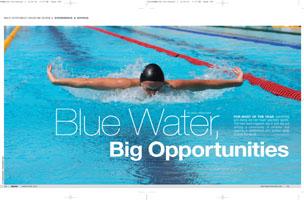
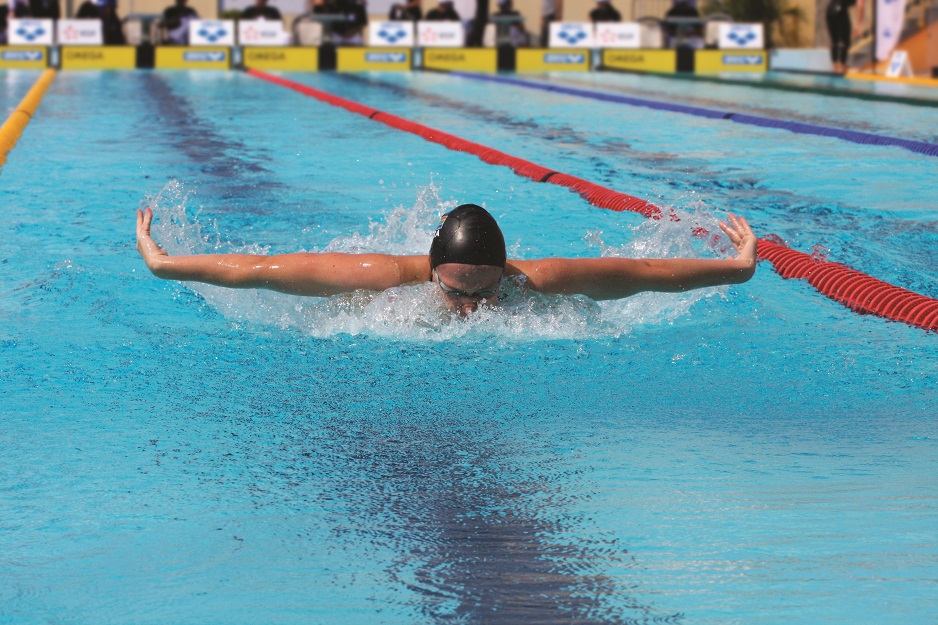 |
| Santamaradona/Dreamstime.com |
For most of the year, swimming and diving are not major spectator sports. The hard work happens day in and day out among a community of athletes and coaches in natatoriums and outdoor pools around the world.
Inevitably, athletes prepare to test their skills against others regionally, nationally, or internationally. Whether it’s for high stakes competition or the fun of participating in a meet, the sports of swimming and diving change dramatically for a few days at a time and become a show when friends, family and fans fill the bleachers.
Right now, the need for facilities that can handle that show is high.
Dean Ekeren, events and marketing director for USA Swimming—the national governing body for swimming in the United States, has been seeing strong interest in aquatics. “Certainly every Olympics year, we see a bump in our membership,” he says. “Right now is a very good time for us. We have several superstars in the sport. We have several athletes who are household names. I think right now we are kind of riding the peak of our popularity.”
Some cities have facilities with long track records of hosting events, while others are renovating or building new aquatic centers to meet the needs of today’s athletes, coaches, and governing bodies.
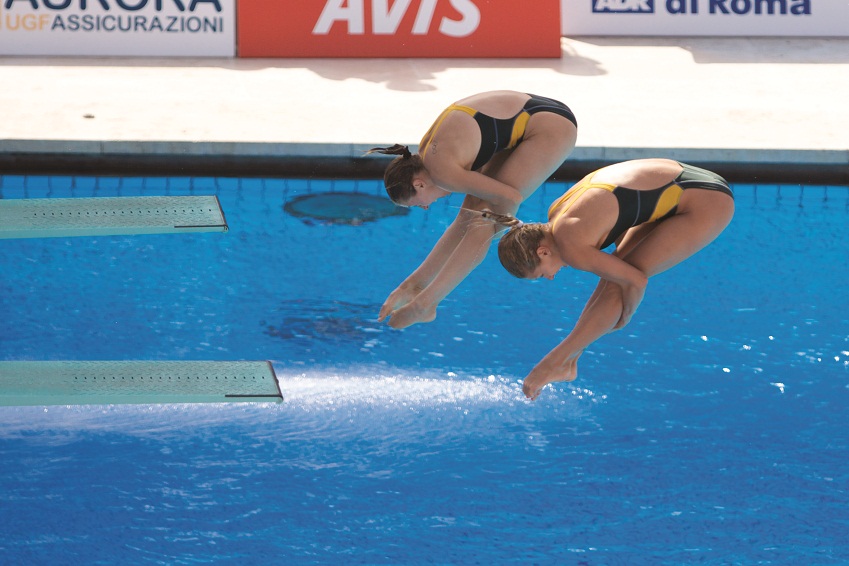 Competitive Swimming: The Specs
Competitive Swimming: The Specs
Not every facility can accommodate all levels of competition or will be a good match for the number of spectators you expect. Exact pool specifications vary depending on the governing body and level of competition. The international governing body for competitive swimming and diving, Fédération Internationale de Natation (FINA), sets guidelines for competition pools. FINA requires a competition-level pool to be 25 meters or 50 meters long and at least 1.35 meters deep.
A pool suitable for Olympic competition must be 50 meters in length (25 meters for the World Swimming Championships) by 25 meters wide, divided into eight lanes of 2.5 meters each (10 lanes for the World Championship and Olympic Games), plus two areas of 2.5 meters at each side of the pool.
In the United States, the National Collegiate Athletic Association (NCAA) sanctions 50-meter pools for long-course swims and 25 meters for short-course swims. The National Federation of State High School Associations (NFHS) allows high schools to use 25-meter-long pools for competitions.
Governing bodies also set out multiple specifications for officiating equipment, number and types of judges, water temperature, lighting, and more.
Competitive Diving: The Specs
Competitive diving also falls under FINA, and is governed in the United States by USA Diving. Springboard events include the 1-meter and 3-meter boards. Platform diving takes place from 5-meter, 7.5-meter and 10-meter platforms, or towers.
High school diving generally uses the springboard. Platform diving typically starts on the collegiate level. The diving area of an aquatics center must be separated from the competitive swimming area.
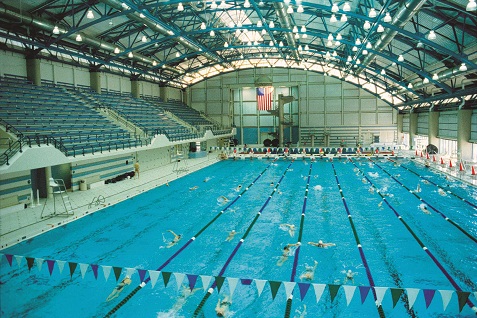 |
| Long Island's Nassau County Aquatic Center, built in 1998 for the Goodwill Games, hosted the 2006 FINA World Cup. Photo courtesy of Nassau County Aquatic Center. |
Lanes and Wells in Northern Latitudes
Flanked by Long Island Sound on one side and the Atlantic Ocean on the other, East Meadow, New York on Long Island is home to an indoor aquatic center that on any given day could be the site of a local toddler’s first swim lesson or of an international competition hosting giants in the fields of swimming and diving.
“Our biggest swimming and diving center is our Nassau County Aquatic Center,” says Jennifer Rothman, sales manager for the Long Island Convention and Visitors Bureau and Sports Commission. “It is one of the top 10 facilities in the country. We did have the 2006 FINA World Cup here.”
The center, which was built in 1998 for the Goodwill Games, contains a 50-meter competition pool (68-meters long with three moveable bulkheads) with a shallow section with moveable floors. The diving well is 17 feet deep and has two 1-meter and two 3-meter springboards, as well as competition platforms at 1, 3 , 5, 7.5, and 10 meters. There is seating for 1,700, as well as amenities including a timing room, press room, showers, locker rooms and more.
Note: Nassau County Aquatic Center is closing for renovations and is expected to reopen early in 2013.
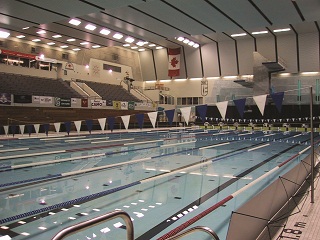 |
| The University of Toronto's Olympic-sized Varsity Pool has a history of hosting competitions such as the Canadian Interuniversity Sports (CIS) Championships. Photo courtesy of the University of Toronto. |
Slightly to the Northwest, Toronto—Canada’s largest city and an international cultural hub—is expanding its swimming and diving competition capabilities. A major upgrade to athletic facilities in the city is underway for the 2015 Pan/Parapan American Games. New construction includes the Pan American Aquatics Centre, which will be a world-qualifying facility, and is scheduled for completion in 2014. The center has already begun booking events beyond the 2015 Pan American Games.
“We have secured different national swimming competitions that will be housed or hosted in that facility, so it gives the swimming and diving world a place to go to use the best possible facility,” says Robert Kawamoto, director of sales, Greater Toronto Regions, for Tourism Toronto.
The new facility will contain two Olympic-sized 52-meter pools and a 10-meter diving tank. A full timing system with integrated starting blocks will also be available. Additionally, the facility will be fully accessible, as it is being constructed to meet standards for hosting the 2015 Parapan American Games. The gallery overlooking the pool will have seating for up to 10,000. The deck space around the pool will also have permanent seating to accommodate up to 750 athletes, coaches, and officials.
Toronto has two competitive pools in addition to the 'crown jewel' Pan American Aquatics Centre. The University of Toronto’s Varsity Pool has hosted competitions such as the Canadian Interuniversity Sport (CIS) Championships. The Olympic-sized Varsity Pool has a moveable bulkhead and 1- and 3-meter springboards and 3- and 5-meter platforms.
The Etobicoke Olympium, an Olympic-sized pool with diving platforms at 3-, 5-, 7-, and 10-meters and two springboards each at 1- and 3-meters, will be renovated in advance of the Pan Am Games. The facility, known as a 'fast' pool, has gallery seating for 747 and deck seating for 837.
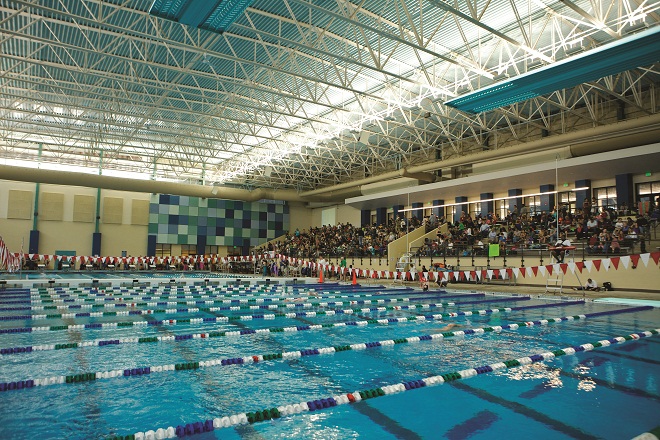 |
| The Birmingham CrossPlex, built in 2011, closes a gap in Birmingham aquatics. Future construction is expected to increase Birmingham's ability to bid on events even further. Photo courtesy of Greater Birmingham Convention and Visitors Bureau |
From Southern Springboards to Swim Meets
A short 10-minute ride from Birmingham International Airport puts you in the waters of the 750,000-square-foot athletic facility, the Birmingham CrossPlex, built in 2011. This facility closes a gap in Birmingham aquatics by adding a 50-meter pool to the city.
“Birmingham has many other pools that host swimming and diving events but none that are 50 meter,” says Tonia Whatley, National Sports Sales Manager for the Greater Birmingham Convention and Visitors Bureau.
The natatorium has ten 50-meter lanes, and its diving facilities include two 1-meter and two 3-meter springboards. It offers a state-of-the-art timing system and sound system. Additionaly, the facility has men’s and women’s locker rooms and showers and meet management and first aid rooms. The natatorium can hold up to 1,300 spectators.
The complex is expected to have increased aquatics capabilities in the future.
Worth noting also is the Lakeshore Foundation, a certified Olympic and Paralympic training facility, with both a therapeutic pool and a competition pool.
Moving from the foothills of the Appalachian Mountains of Alabama to Central Florida, a trip to Gainesville is an opportunity for competitive aquatics. The city has several competition-level swimming and diving facilities through the University of Florida and the city’s Parks and Recreation Division.
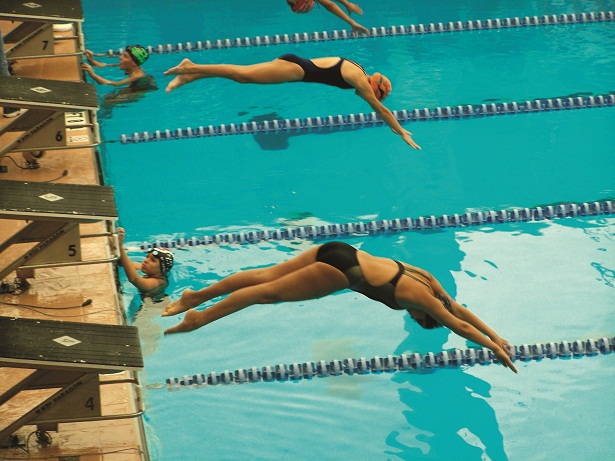 |
| Gainesville's Gator Swim Club is based at the University of Florida's O'Connell Center Pool. Photo courtesy of Richard Ritari. |
“The [University of Florida] natatorium accommodates NCAA diving” says Jack Hughes, executive director of the Gainesville Sports Commission. We’ve held the world’s largest synchronized swimming event there. It is an Olympic eight-lane pool. There are also two other Olympic pools owned by the city of Gainesville.”
The 50-meter O’Connell Center Pool at the University of Florida also has 1-meter and 3-meter diving springboards and platforms at 5 and 10 meters. The natatorium is equipped with a locker room, accessibility lift and seating for at least 3,000 spectators. The Florida Pool, an outdoor pool also at the University of Florida, is heated in winter.
The city owns the Albert “Ray” Massey (Westside) Pool, a 50-meter pool with 1- and 3-meter springboards, as well as diving platforms. And the Dwight H. Hunter (Northeast) Pool is also 50-meters, with 1- and 3-meter diving springboards.
The Daytona State College Aquatic Center contains a 25-yard x 25-meter indoor, heated pool. The pool is used for community swimming, the college’s aquatic teams, and competitive activities.
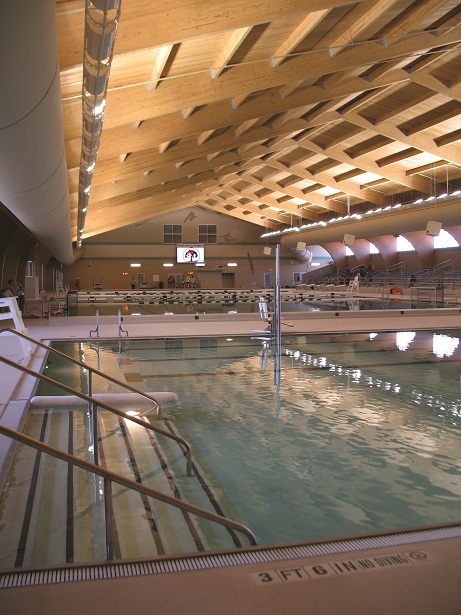 |
| The City of Pearland, Texas, recently increased its aquatics capabilities with the construction of its Recreation Center and Natatorium, which began holding events in the fall of 2010. Photo courtesy of the Pearland Chamber of Commerce. |
Aquatics in the Southwest
A new aquatics facility in Pearland, Texas positions the town to offer competitive events that provide visitors with the pace of a smaller city combined with the major-city benefits of Houston just 20-minutes away.
Billy Pounds, aquatics manager for Pearland Parks and Recreation, oversees operations of Pearland’s Recreation Center and Natatorium.
“We have several events coming up,” says Pounds. “We have everything from summer league swim meets to regional championship meets for USA Swimming. We are the host facility for the two Pearland high schools and their invitational swim meets. In October 2010, we hosted the 2010 Fall Classic for Special Olympics. It was sort of our inaugural opening event.”
The competition pool at the natatorium is 25 yards, with 8 lanes. Its diving facilities include two 1-meter, and two 3-meter springboards. Poolside seating can accommodate 700 people, with temporary bleachers for another 200 to 300 in the deck area.
“There is plenty of ‘wow’ when people walk into the facility the first time, and we want them to keep coming back,” says Pounds.
The convenience of Pearland’s hotels is another factor that may help keep people coming back.
“All of our hotels have easy access to the natatorium and other sporting venues,” says Carol Artz-Bucek, President and CEO of the Pearland Chamber of Commerce.
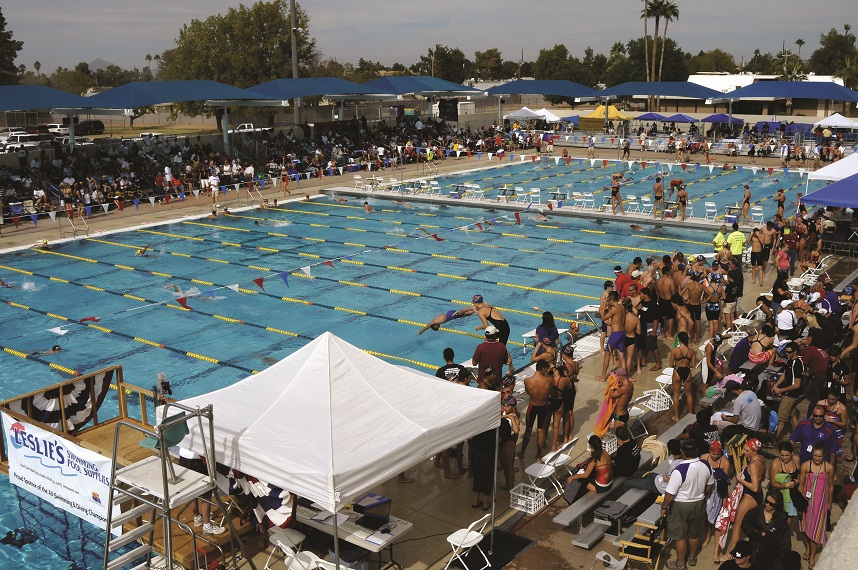 |
| The Kino Aquatic Center is one of Mesa, Arizona's premier swimming and diving facilities. The center recently hosted the U.S. Masters Swimming Short Course National Championships. Photo courtesy of Mesa Convention and Visitors Bureau. |
Aquatics in the dessert are big in Mesa, Arizona, which recently added its ninth aquatic center.
“Our weather allows for any investment in this sport to pay dividends because it can take place year-round,” says Michelle Streeter, director of public relations for the Mesa Convention and Visitors Bureau. “Mesa has also been considered a winter haven and admired for the desert warmth and scenic beauty.”
The city’s premier aquatics facilities are the Kino Aquatic Center and the new Skyline Aquatic Center. The Kino Aquatic Center recently hosted the U.S. Masters Swimming Short Course National Championships.
“This was by far the most well-attended event at Kino Aquatic Center with 1,800 swimmers in attendance,” says Streeter.
Both the Kino Aquatic Center and the Skyline Aquatic Center contain a 28-lane, Olympic-sized state-of-the-art competition pool with two 1-meter, and two 3-meter diving boards. Necessitated by the desert sun, each aquatic center also has shade structures and a turf area.
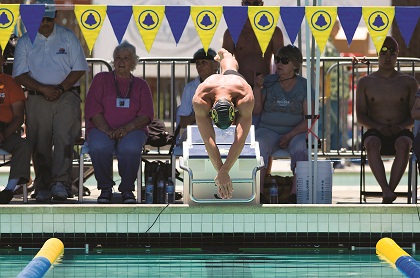 |
| The George F. Haines International Swim Center hosted the Santa Clara Swim Club's 44th annual International Invitational Swim Meet last summer. Photo courtesy of Tim Tower. |
A West Coast Winning Tradition
The Santa Clara Swim Club has a long history of producing Olympic athletes. In its 55 years of existence, the club has produced 51 Olympic gold medals, 17 silver, and 12 bronze. The swim club is based at the renowned George F. Haines International Swim Center. It is the home of the Santa Clara Aquamaids synchronized swimming team and Santa Clara Diving.
“We have everything from first swim meet to Olympian. It’s a really cool welcoming venue like that,” says Jaime Benes, Chief Operating Officer for the Santa Clara Swim Club, who describes the center as “a really vibrant place from Monday though Saturday morning.”
The George F. Haines International Swim Center is an outdoor venue that includes three heated swimming pools. The main pool is 25 yards by 50 meters and can be reconfigured for different types of events. The other two pools are each 6-lane, 25-yard pools, one of which is a 17-foot-deep diving well. A large, covered bleacher space can accommodate 5,000 spectators and participants.
For sports event planners who faced with housing groups of children, there’s an easy option.
“We are right by Santa Clara University. If you were doing an event and you needed to house kids, they rent out their dorms,” says Benes.

